Extracts from Dark Tea with Dual Effects of Anti-Melanogenesis and Prevention of Post-Inflammatory Hyperpigmentation
Abstract
1. Introduction
2. Materials and Methods
2.1. Preparation of DTE
2.2. Determination of Total Phenolics in DTE
2.3. Chemical Composition Determination of DTE
2.4. Cell Cultures
2.5. Melanin Content and Tyrosinase Activity Assays in B16 Cells
2.5.1. Cell Viability of B16 Cells
2.5.2. Melanin Content Assay
2.5.3. Tyrosinase Activity Assay
2.6. The PIH Inhibitory Effect of DTE Measured by HaCaT Cells
2.6.1. Cell Viability of HaCaT Cells
2.6.2. Determination of Secretion of Inflammatory Factors (IL-1α and IL-1β) and Paracrine Melanogenic Factors (ET-1, α-MSH, and bFGF) by ELISA
2.7. RT-PCR Analysis
2.8. Western Blot Analysis
2.9. Statistical Analysis
3. Results
3.1. Determination of Polyphenol Content in DTE
3.2. The Determination Results of the Chemical Composition of DTE
3.3. Effect of DTE on Melanin Content and Tyrosinase Activity in B16 Cells
3.4. Effects of DTE on Inflammatory and Paracrine Melanogenic Factors in UVB-Irradiated HaCaT Cells
3.5. DTE Exerted Anti-Inflammatory Effect Through p38 MAPK/Nrf2/HO-1 Pathway in HaCaT Cells
3.6. DTE Exerted Anti-Melanogenesis Effect Through MC1R, MITF, TYR, and TYRP-1/2 Pathway in B16 Cells
4. Discussion
5. Conclusions
Author Contributions
Funding
Institutional Review Board Statement
Informed Consent Statement
Data Availability Statement
Conflicts of Interest
References
- Maghfour, J.; Olayinka, J.; Hamzavi, I.H.; Mohammad, T.F. A focused review on the pathophysiology of post-inflammatory hyperpigmentation. Pigment Cell Melanoma Res. 2022, 35, 320–327. [Google Scholar] [CrossRef]
- Kashetsky, N.; Feschuk, A.; Pratt, M.E. Post-inflammatory hyperpigmentation: A systematic review of treatment outcomes. J. Eur. Acad. Dermatol. Venereol. 2024, 38, 470–479. [Google Scholar] [CrossRef]
- Markiewicz, E.; Karaman-Jurukovska, N.; Mammone, T.; Idowu, O.C. Post-inflammatory hyperpigmentation in dark skin: Molecular mechanism and skincare implications. Clin. Cosmet. Investig. Dermatol. 2022, 15, 2555–2565. [Google Scholar] [CrossRef]
- Alexis, A.F.; Sergay, A.B.; Taylor, S.C. Common dermatologic disorders in skin of color: A comparative practice survey. Cutis 2007, 80, 387–394. [Google Scholar]
- Hu, J.K.; Quinonez, R.L.; Antasiuk, V.; Waibel, J. Treatment of acne vulgaris-associated post-inflammatory dyschromia with combination of non-ablative laser therapy and topical antioxidants. J. Drugs Dermatol. 2024, 23, 769–773. [Google Scholar] [CrossRef]
- Chiang, C.; Ward, M.; Gooderham, M. Dermatology: How to manage acne in skin of colour. Drugs Context 2022, 11, 2021-10-9. [Google Scholar] [CrossRef] [PubMed]
- Zheng, W.J.; Wan, X.C.; Bao, G.H. Brick dark tea: A review of the manufacture, chemical constituents and bioconversion of the major chemical components during fermentation. Phytochem. Rev. 2015, 14, 499–523. [Google Scholar] [CrossRef]
- Aloo, O.S.; Kim, D.G.; Vijayalakshmi, S.; Aloo, D.O.; Ochola, C.O.; Oh, D.H. Polyphenol constituents and impacts of fermented teas (Camellia sinensis) in human wellness. Food Biosci. 2024, 60, 104389. [Google Scholar] [CrossRef]
- Albouy, M.; Aubailly, S.; Jeanneton, O.; Marteau, C.; Sobilo, L.; Boulgana, R.; Bru, G. Skin-protective biological activities of bio-fermented Aframomum angustifolium extract by a consortium of microorganisms. Front. Pharmacol. 2023, 14, 1303198. [Google Scholar] [CrossRef]
- Lee, N.Y.; Jo, C.; Sohn, S.H.; Kim, J.K.; Byun, M.W. Effects of gamma irradiation on the biological activity of green tea byproduct extracts and a comparison with green tea leaf extracts. J. Food Sci. 2006, 71, C269–C274. [Google Scholar] [CrossRef]
- Lin, F.J.; Wei, X.L.; Liu, H.Y.; Li, H.; Xia, Y.; Wu, D.T.; Zhang, P.Z.; Gandhi, G.R. State-of-the-art review of dark tea: From chemistry to health benefits. Trends Food Sci. Technol. 2021, 109, 126–138. [Google Scholar] [CrossRef]
- Zhu, M.Z.; Li, N.; Zhou, F.; Ouyang, J.; Lu, D.M.; Xu, W.; Li, J.; Lin, H.Y.; Zhang, Z.; Xiao, J.B.; et al. Microbial bioconversion of the chemical components in dark tea. Food Chem. 2020, 312, 126043. [Google Scholar] [CrossRef]
- Deng, H.; Liu, J.; Xiao, Y.; Wu, J.L.; Jiao, R. Possible mechanisms of dark tea in cancer prevention and management: A comprehensive review. Nutrients 2023, 15, 3903. [Google Scholar] [CrossRef]
- Zhang, Y.; Shi, F.J.; Yang, Y.X. Research on the determination of total polyphenol content in grape spirits by Folin-Ciocalteu colorimetric method. China Brew. 2017, 36, 163–166. [Google Scholar]
- Petpiroon, N.; Rosena, A.; Pimtong, W.; Charoenlappanit, S.; Koobkokkruad, T.; Roytrakul, S.; Aueviriyavit, S. Protective effects of Thai silk sericins and their related mechanisms on UVA-induced phototoxicity and melanogenesis: Investigation in primary melanocyte cells using a proteomic approach. Int. J. Biol. Macromol. 2022, 201, 75–84. [Google Scholar] [CrossRef] [PubMed]
- Ma, W.; Shi, Y.; Yang, G.; Shi, J.; Ji, J.; Zhang, Y.; Wang, J.; Peng, Q.; Lin, Z.; Lv, H. Hypolipidaemic and antioxidant effects of various Chinese dark tea extracts obtained from the same raw material and their main chemical components. Food Chem. 2022, 375, 131877. [Google Scholar] [CrossRef]
- Peng, S.; Lin, L.; Zhao, M. A comparative study on the bioactivities and chemical compositions of Dancong summer tea and Anhua dark tea: Excavation of glycolipid-lowering functional factors. Food Res. Int. 2025, 204, 115825. [Google Scholar] [CrossRef] [PubMed]
- Serre, C.; Busuttil, V.; Botto, J.M. Intrinsic and extrinsic regulation of human skin melanogenesis and pigmentation. Int. J. Cosmet. Sci. 2018, 40, 328–347. [Google Scholar] [CrossRef]
- Yuan, I.H.; Jin, Z.H. Paracrine regulation of melanogenesis. Br. J. Dermatol. 2018, 178, 632–639. [Google Scholar] [CrossRef]
- Eves, P.C.; MacNeil, S.; Haycock, J.W. α-Melanocyte stimulating hormone, inflammation and human melanoma. Peptides 2006, 27, 444–452. [Google Scholar] [CrossRef]
- Wang, W.; Gao, Y.; Wang, W.W.; Zhang, J.Y.; Yin, J.F.; Le, T.; Xue, J.J.; Engelhardt, U.H.; Jiang, H.Y. Kojic Acid Showed Consistent Inhibitory Activity on Tyrosinase from Mushroom and in Cultured B16F10 Cells Compared with Arbutins. Antioxidants 2022, 11, 502. [Google Scholar] [CrossRef]
- Chen, Y.; Lian, N.; Chen, S.; Xiao, T.; Ke, Y.; Zhang, Y.; Song, C.; Yang, Y.; Xu, S.; Gu, H.; et al. Gsdme deficiency leads to the aggravation of UVB-induced skin inflammation through enhancing recruitment and activation of neutrophils. Cell Death Dis. 2022, 13, 841. [Google Scholar] [CrossRef]
- Kim, L.; Kim, J.Y. Chondroprotective effect of curcumin and lecithin complex in human chondrocytes stimulated by IL-1β via an anti-inflammatory mechanism. Food Sci. Biotechnol. 2019, 28, 547–553. [Google Scholar] [CrossRef]
- Wu, K.C.; Hseu, Y.C.; Shih, Y.C.; Sivakumar, G.; Syu, J.T.; Chen, G.L.; Lu, M.T.; Chu, P.C. Calycosin, a common dietary isoflavonoid, suppresses melanogenesis through the downregulation of PKA/CREB and p38 MAPK signaling pathways. Int. J. Mol. Sci. 2022, 23, 1358. [Google Scholar] [CrossRef] [PubMed]
- Chung, Y.C.; Kim, S.; Kim, J.H.; Lee, G.S.; Lee, J.N.; Lee, N.H.; Hyun, C.G. Pratol, an O-methylated flavone, induces melanogenesis in B16F10 melanoma cells via p-p38 and p-JNK upregulation. Molecules 2017, 22, 1704. [Google Scholar] [CrossRef] [PubMed]
- O’Rourke, S.A.; Shanley, L.C.; Dunne, A. The Nrf2-HO-1 system and inflammaging. Front. Immunol. 2024, 15, 1457010. [Google Scholar] [CrossRef] [PubMed]
- Wang, F.; Ma, W.; Fan, D.; Hu, J.; An, X.; Wang, Z. The biochemistry of melanogenesis: An insight into the function and mechanism of melanogenesis-related proteins. Front. Mol. Biosci. 2024, 11, 1440187. [Google Scholar] [CrossRef]
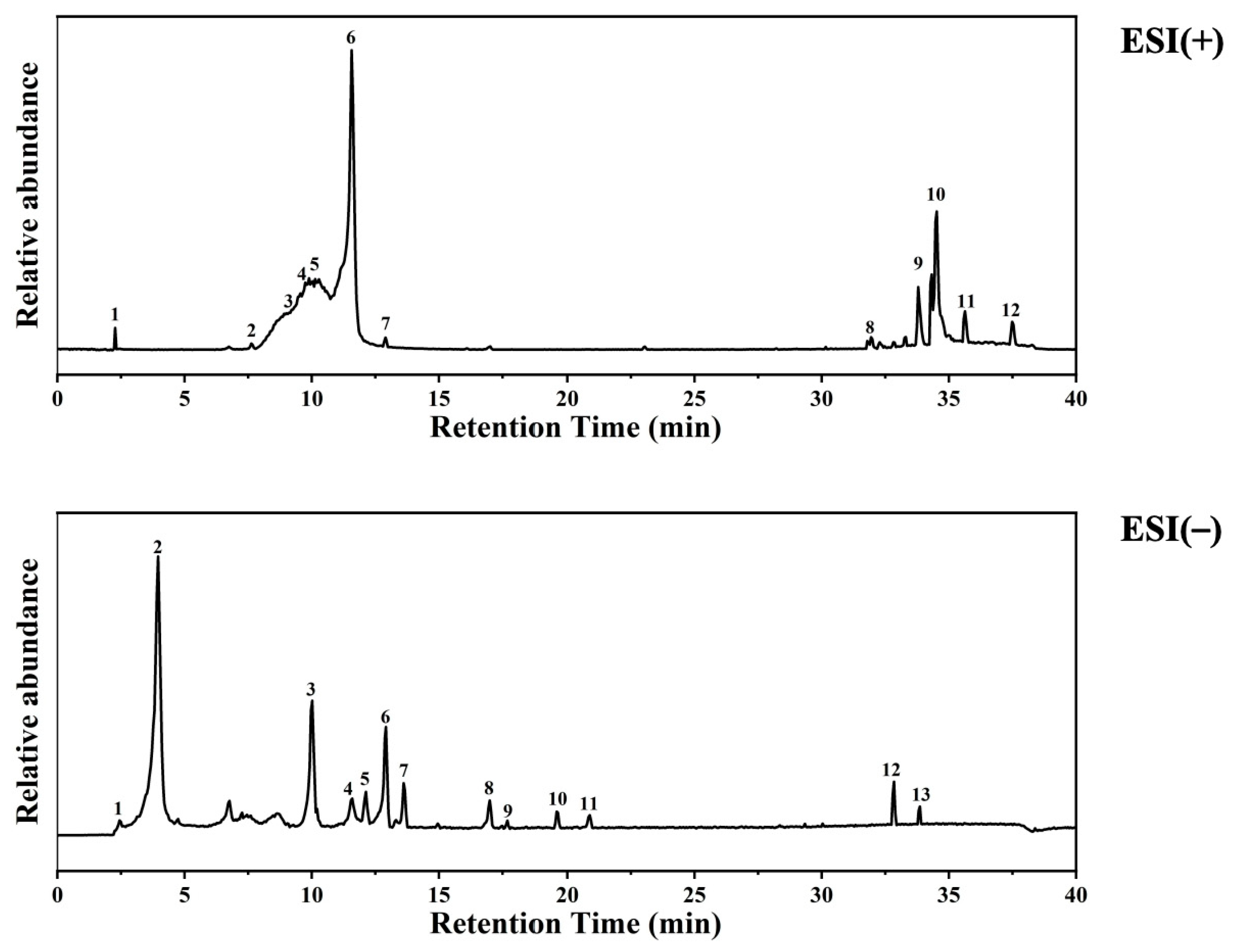
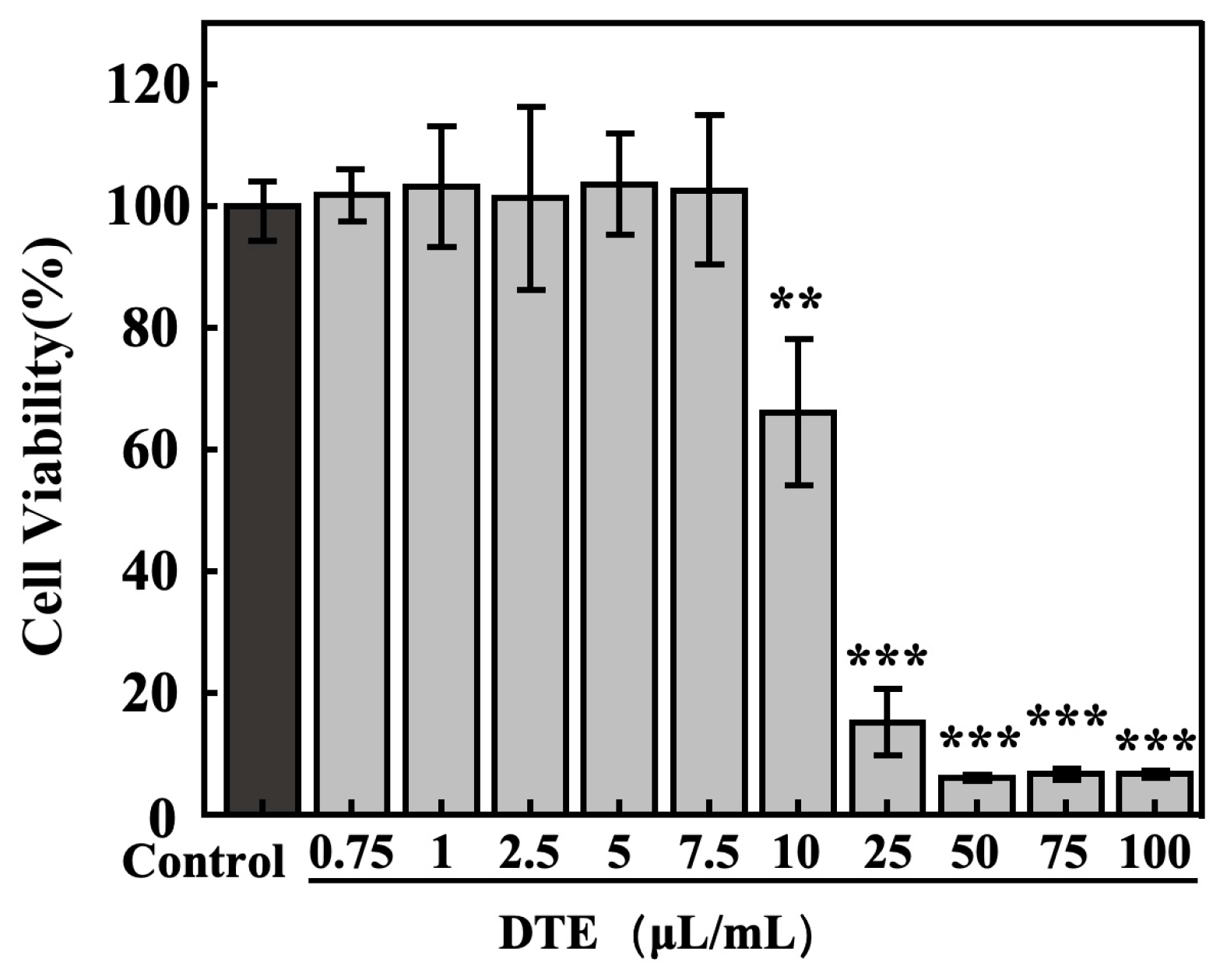

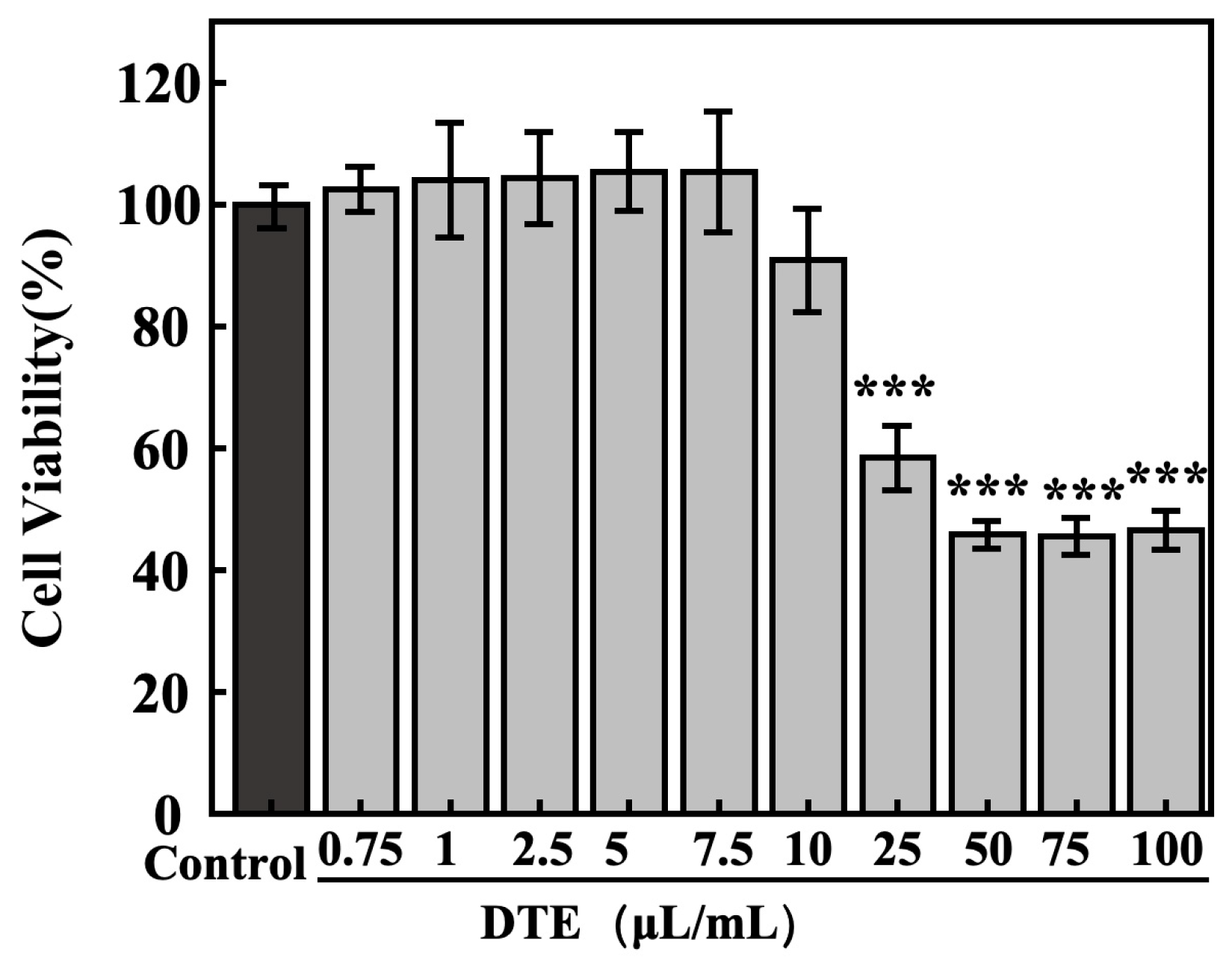
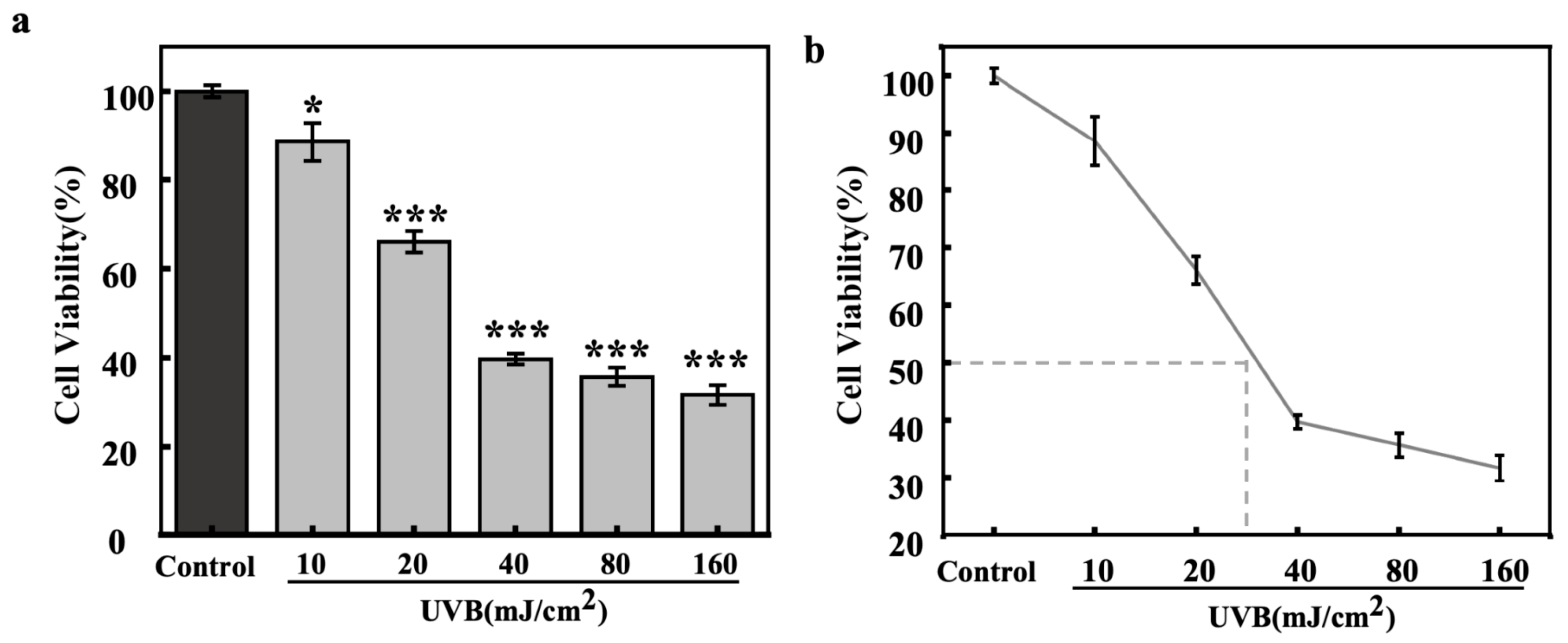
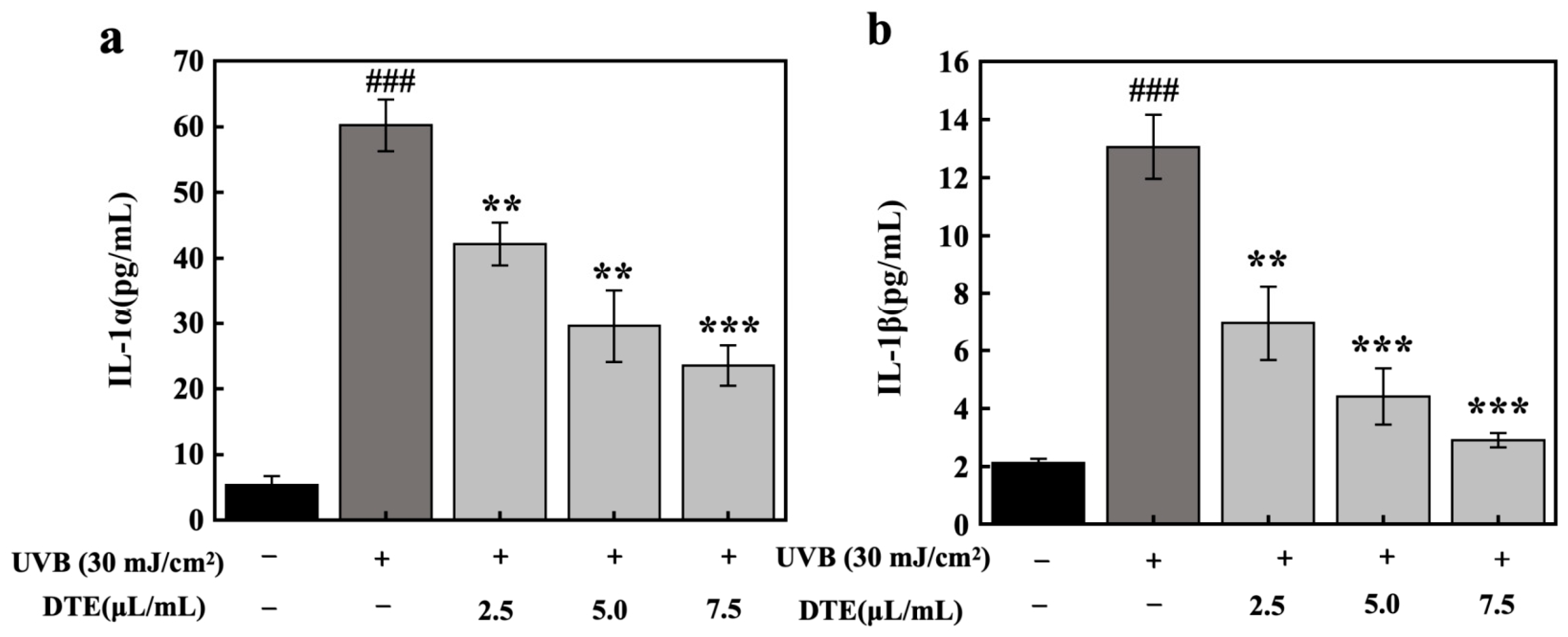


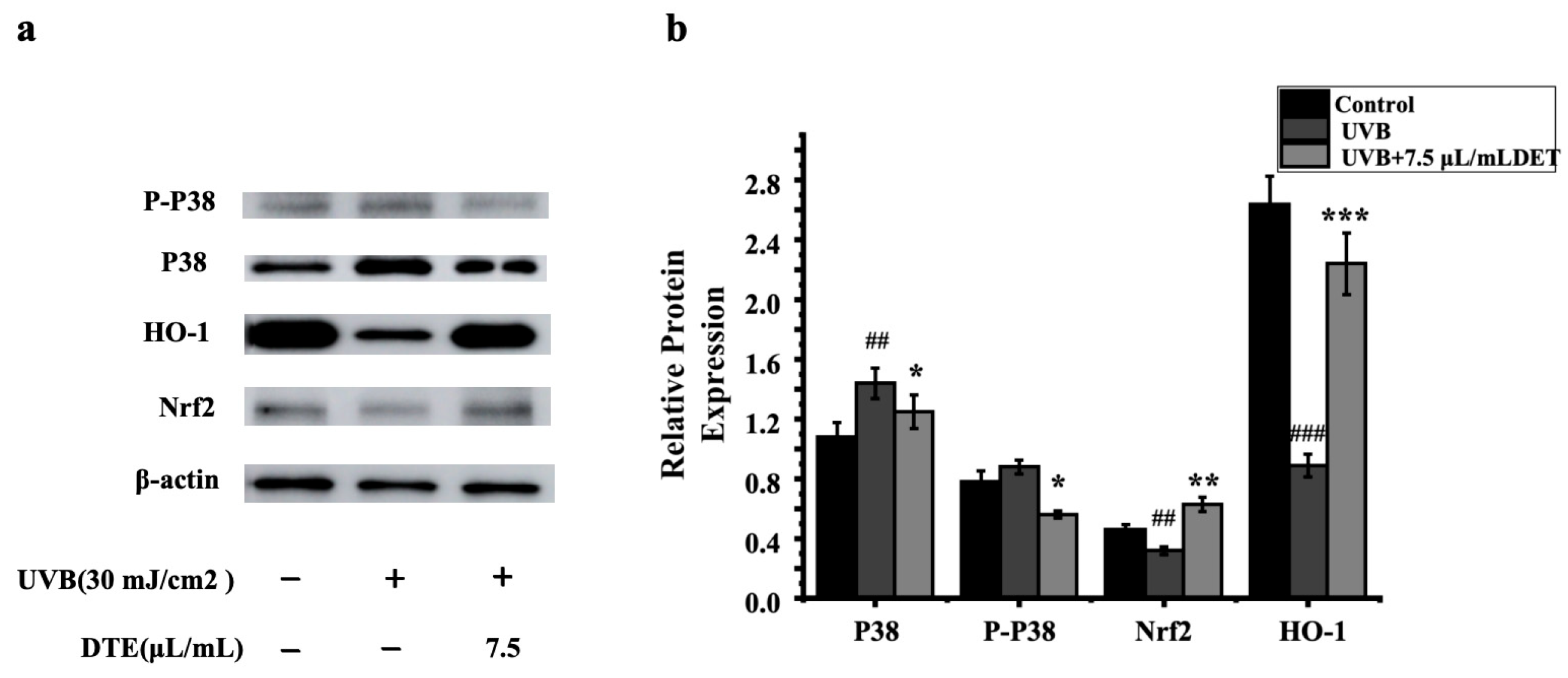
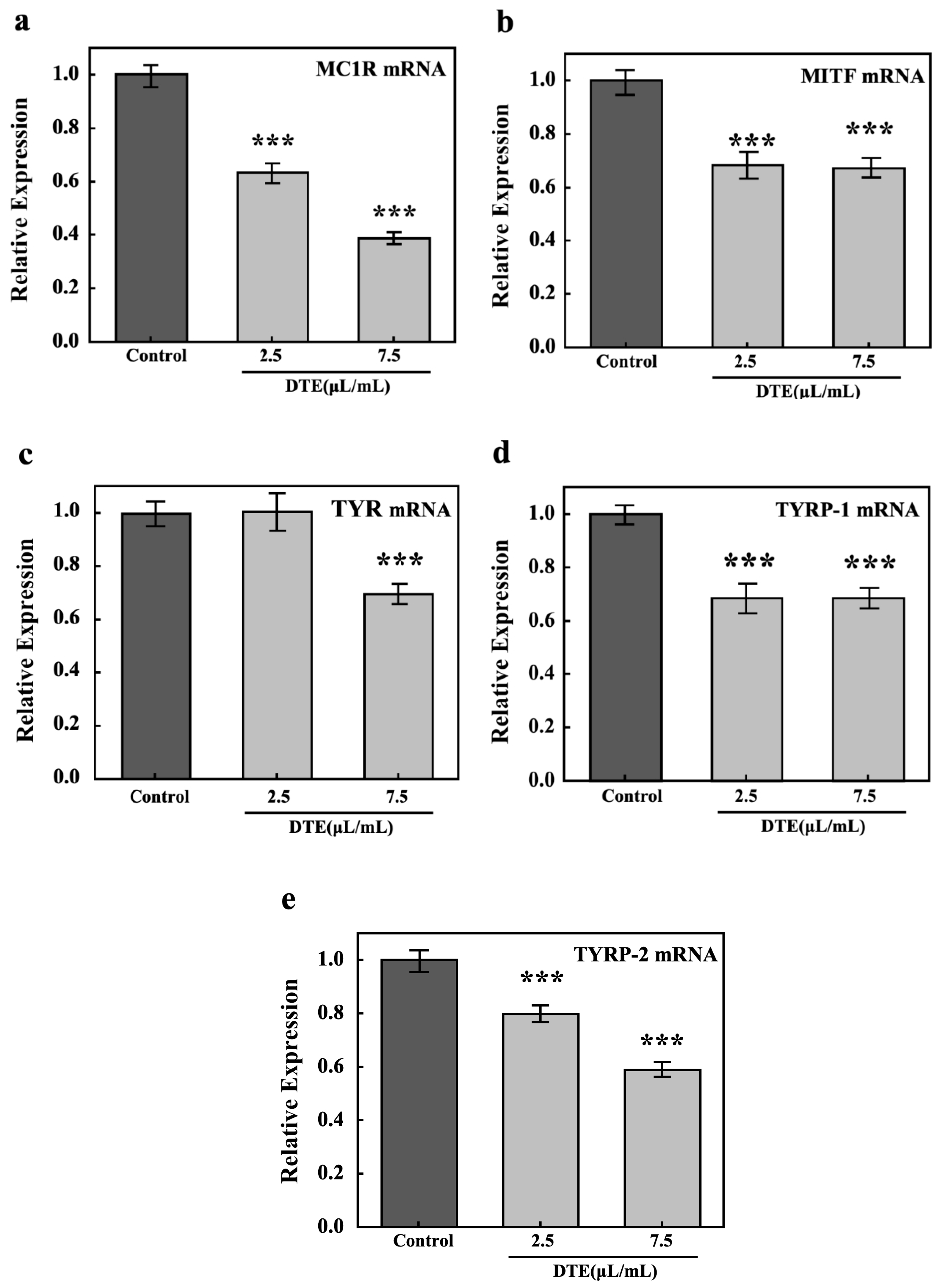

| Cells | Gene | Primers (5′-3′) |
|---|---|---|
| HaCaT | MC1R | F:CTCATTGACGTGCTCATCTGTGG |
| R:TGCTTGTAGTAGGTGATAAAGAGGGT | ||
| MITF | F:GCCCTATGGCTATGCTCACTCTT | |
| R:TGTTCATACCTGGGCACTCACTC | ||
| TYR | F:ATCCTAACTTACTCAGCCCAGCA | |
| R:CTCAGGTGTTCCATCGCATAAA | ||
| TYRP-1 | F:TTCGTTGGAGCTGTGATTGTTG | |
| R:AGGAATAATGTTGAAAGGTGGGG | ||
| TYRP-2 | F:CAGAAATAATGAGAAACTGCCAACC | |
| R:TCCGTCTGCTTTATCAAACCCT | ||
| GAPDH | F:CCTCGTCCCGTAGACAAAATG | |
| R:TGAGGTCAATGAAGGGGTCGT | ||
| B16 | p38 MAPK | F:TTATGCGTCTGACAGGAACACC |
| R:CAATACAAGCATCTTCTCCAGCA | ||
| Nrf2 | F:TGAGGTTTCTTCGGCTACGTT | |
| R:CTTCTGTCAGTTTGGCTTCTGG | ||
| HO-1 | F:ATGCCCCAGGATTTGTCAGAG | |
| R:GGAAGTAGACAGGGGCGAAGAC | ||
| GAPDH | F:GGAAGCTTGTCATCAATGGAAATC | |
| R:TGATGACCCTTTTGGCTCCC |
| Peak Name | m/z | RT [min] | Name | Adduct |
|---|---|---|---|---|
| 1 | 104.10725 | 2.367 | Choline | [M + H] + 1 |
| 2 | 181.07182 | 7.632 | Theobromine | [M + H] + 1 |
| 3 | 205.09688 | 9.357 | DL-Tryptophan | [M + H] + 1 |
| 4 | 181.07169 | 9.644 | Theophylline | [M + H] + 1 |
| 5 | 139.03871 | 10.062 | 3,4-Dihydroxybenzaldehyde | [M + H] + 1 |
| 6 | 195.08733 | 11.57 | Caffeine | [M + H] + 1 |
| 7 | 139.03876 | 12.893 | 3,4-Dihydroxybenzaldehyde | [M + H] + 1 |
| 8 | 301.14059 | 31.955 | Dibutyl phthalate | [M + Na] + 1 |
| 9 | 256.26309 | 34.314 | Hexadecanamide | [M + H] + 1 |
| 10 | 282.27856 | 34.507 | Oleamide | [M + H] + 1 |
| 11 | 284.29422 | 35.631 | Stearamide | [M + H] + 1 |
| 12 | 360.32294 | 37.502 | Erucamide | [M + Na] + 1 |
| Peak Name | m/z | RT [min] | Name | Adduct |
|---|---|---|---|---|
| 1 | 346.05634 | 2.463 | Adenosine 5′-monophosphate | [M − H] − 1 |
| 2 | 169.01353 | 3.95 | Gallic acid | [M − H] − 1 |
| 3 | 153.01845 | 10.013 | Protocatechuic acid | [M − H] − 1 |
| 4 | 289.07227 | 11.57 | Catechin | [M − H] − 1 |
| 5 | 457.07837 | 12.113 | Epigallocatechin gallate | [M − H] − 1 |
| 6 | 289.07217 | 12.896 | Catechin | [M − H] − 1 |
| 7 | 163.039 | 13.618 | 3-Coumaric acid | [M − H] − 1 |
| 8 | 477.06802 | 16.935 | Miquelianin | [M − H] − 1 |
| 9 | 515.11987 | 17.698 | 4,5-Dicaffeoylquinic acid | [M − H] − 1 |
| 10 | 739.21002 | 19.62 | Kaempferol-3-Galactoside-6″-Rhamnoside-3‴-Rhamnoside | [M − H] − 1 |
| 11 | 187.09721 | 20.865 | Azelaic acid | [M − H] − 1 |
| 12 | 149.09644 | 32.837 | 4-tert-butylphenol | [M − H] − 1 |
| 13 | 339.23337 | 33.849 | 2,2′-Methylenebis(4-methyl-6-tert-butylphenol) | [M − H] − 1 |
Disclaimer/Publisher’s Note: The statements, opinions and data contained in all publications are solely those of the individual author(s) and contributor(s) and not of MDPI and/or the editor(s). MDPI and/or the editor(s) disclaim responsibility for any injury to people or property resulting from any ideas, methods, instructions or products referred to in the content. |
© 2025 by the authors. Licensee MDPI, Basel, Switzerland. This article is an open access article distributed under the terms and conditions of the Creative Commons Attribution (CC BY) license (https://creativecommons.org/licenses/by/4.0/).
Share and Cite
Duo, X.; Wang, J.; Wu, C.; Deng, J.; Huang, Y.; Yu, M.; Ri, K.; Wang, G.; Wang, J. Extracts from Dark Tea with Dual Effects of Anti-Melanogenesis and Prevention of Post-Inflammatory Hyperpigmentation. Cosmetics 2025, 12, 210. https://doi.org/10.3390/cosmetics12050210
Duo X, Wang J, Wu C, Deng J, Huang Y, Yu M, Ri K, Wang G, Wang J. Extracts from Dark Tea with Dual Effects of Anti-Melanogenesis and Prevention of Post-Inflammatory Hyperpigmentation. Cosmetics. 2025; 12(5):210. https://doi.org/10.3390/cosmetics12050210
Chicago/Turabian StyleDuo, Xiaoxiao, Jingting Wang, Chunxia Wu, Jianming Deng, Yuancheng Huang, Min Yu, Kinka Ri, Guangli Wang, and Jing Wang. 2025. "Extracts from Dark Tea with Dual Effects of Anti-Melanogenesis and Prevention of Post-Inflammatory Hyperpigmentation" Cosmetics 12, no. 5: 210. https://doi.org/10.3390/cosmetics12050210
APA StyleDuo, X., Wang, J., Wu, C., Deng, J., Huang, Y., Yu, M., Ri, K., Wang, G., & Wang, J. (2025). Extracts from Dark Tea with Dual Effects of Anti-Melanogenesis and Prevention of Post-Inflammatory Hyperpigmentation. Cosmetics, 12(5), 210. https://doi.org/10.3390/cosmetics12050210





